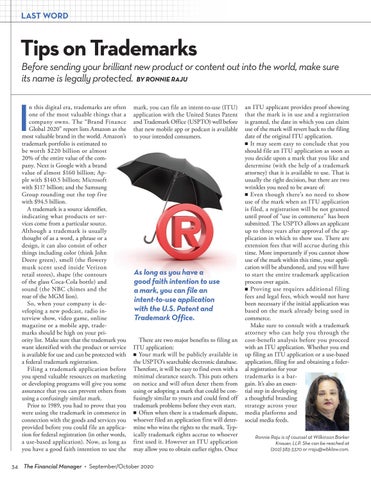LAST WORD
Tips on Trademarks
Before sending your brilliant new product or content out into the world, make sure its name is legally protected. BY RONNIE RAJU
I
n this digital era, trademarks are often one of the most valuable things that a company owns. The “Brand Finance Global 2020” report lists Amazon as the most valuable brand in the world. Amazon’s trademark portfolio is estimated to be worth $220 billion or almost 20% of the entire value of the company. Next is Google with a brand value of almost $160 billion; Apple with $140.5 billion; Microsoft with $117 billion; and the Samsung Group rounding out the top five with $94.5 billion. A trademark is a source identifier, indicating what products or services come from a particular source. Although a trademark is usually thought of as a word, a phrase or a design, it can also consist of other things including color (think John Deere green), smell (the flowery musk scent used inside Verizon retail stores), shape (the contours of the glass Coca-Cola bottle) and sound (the NBC chimes and the roar of the MGM lion). So, when your company is developing a new podcast, radio interview show, video game, online magazine or a mobile app, trademarks should be high on your priority list. Make sure that the trademark you want identified with the product or service is available for use and can be protected with a federal trademark registration. Filing a trademark application before you spend valuable resources on marketing or developing programs will give you some assurance that you can prevent others from using a confusingly similar mark. Prior to 1989, you had to prove that you were using the trademark in commerce in connection with the goods and services you provided before you could file an application for federal registration (in other words, a use-based application). Now, as long as you have a good faith intention to use the
mark, you can file an intent-to-use (ITU) application with the United States Patent and Trademark Office (USPTO) well before that new mobile app or podcast is available to your intended consumers.
As long as you have a good faith intention to use a mark, you can file an intent-to-use application with the U.S. Patent and Trademark Office. There are two major benefits to filing an ITU application: ■ Your mark will be publicly available in the USPTO’s searchable electronic database. Therefore, it will be easy to find even with a minimal clearance search. This puts others on notice and will often deter them from using or adopting a mark that could be confusingly similar to yours and could fend off trademark problems before they even start. ■ Often when there is a trademark dispute, whoever filed an application first will determine who wins the rights to the mark. Typically trademark rights accrue to whoever first used it. However an ITU application may allow you to obtain earlier rights. Once
34 The Financial Manager • September/October 2020
an ITU applicant provides proof showing that the mark is in use and a registration is granted, the date in which you can claim use of the mark will revert back to the filing date of the original ITU application. ■ It may seem easy to conclude that you should file an ITU application as soon as you decide upon a mark that you like and determine (with the help of a trademark attorney) that it is available to use. That is usually the right decision, but there are two wrinkles you need to be aware of: ■ Even though there’s no need to show use of the mark when an ITU application is filed, a registration will be not granted until proof of “use in commerce” has been submitted. The USPTO allows an applicant up to three years after approval of the application in which to show use. There are extension fees that will accrue during this time. More importantly if you cannot show use of the mark within this time, your application will be abandoned, and you will have to start the entire trademark application process over again. ■ Proving use requires additional filing fees and legal fees, which would not have been necessary if the initial application was based on the mark already being used in commerce. Make sure to consult with a trademark attorney who can help you through the cost-benefit analysis before you proceed with an ITU application. Whether you end up filing an ITU application or a use-based application, filing for and obtaining a federal registration for your trademarks is a bargain. It’s also an essential step in developing a thoughtful branding strategy across your media platforms and social media feeds. Ronnie Raju is of counsel at Wilkinson Barker Knauer, LLP. She can be reached at (202) 383-3370 or rraju@wbklaw.com.







